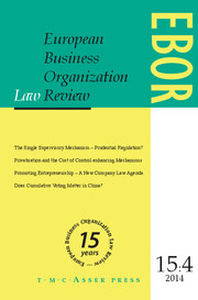Article contents
Promoting Entrepreneurship – The New Company Law Agenda
Published online by Cambridge University Press: 17 December 2014
Abstract
Promoting entrepreneurship is high on the agenda at both European and national level. This is, e.g., reflected in a number of company law initiatives, which have mainly focused on creating easier and cheaper access to limited liability, for example, by introducing sub-types of the private limited company. The main questions addressed here are whether it is possible to promote entrepreneurship through company law reforms and what the content of such frameworks should be in order to meet the needs of entrepreneurs. The analysis takes its point of departure in a new Danish survey of what the content of company legislation should be in order to meet the needs of entrepreneurs. In line with existing empirical studies, the importance of the capital requirement and formation procedures and costs is analysed, and further insight is given into, for example, what level of minimum capital and cost is regarded as acceptable. Besides this insight, the Danish survey adds to the existing studies and literature by also shedding light on whether company laws can be further optimised, for instance, by introducing more flexible rules for company management, etc. The results of the survey are compared with the reforms which, in recent years, have been adopted in several EU Member States, with the aim of evaluating whether these have met the needs indicated in the survey. The overall conclusion is that this is not the case on all points and that there is thus room for improvement. It is also briefly discussed whether the different reform methods used in the recent national reforms are well-suited for further optimising the legislation and it is shown that the method of introducing sub-types of private limited companies has its limitations.
- Type
- Articles
- Information
- European Business Organization Law Review (EBOR) , Volume 15 , Issue 4 , December 2014 , pp. 545 - 584
- Copyright
- Copyright © T.M.C. Asser Press and the Authors 2014
- 4
- Cited by


